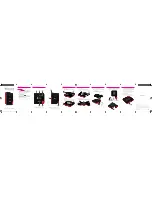
17
Introduction
Figure 1-1
Sample AP-2500
Hotspot Configuration
The AP-2500 supports the full set of wireless networking features that are typically available with traditional access
points (that is, access points that do not supply hotspot connectivity), including:
•
Easy installation and operation
•
Over-the-air encryption of data
•
High speed network links
•
Support for multiple IEEE standards
IEEE 802.11 Specifications
In 1997, the Institute of Electrical and Electronics Engineers (IEEE) adopted the 802.11 standard for wireless devices
operating in the 2.4 GHz frequency band. This standard includes provisions for three radio technologies: direct
sequence spread spectrum, frequency hopping spread spectrum, and infrared. Devices that comply with the 802.11
standard operate at a data rate of either 1 or 2 Megabits per second (Mbits/sec).
In 1999, the IEEE modified the 802.11 standard to support direct sequence devices that can operate at speeds of up to
11 Mbits/sec. The IEEE ratified this standard as
802.11b
. 802.11b devices are backwards compatible with 2.4 GHz
802.11 direct sequence devices (that operate at 1 or 2 Mbits/sec).
Also in 1999, the IEEE modified the 802.11 standard to support devices operating in the 5 GHz frequency band. This
standard is referred to as
802.11a
. 802.11a devices are not compatible with 2.4 GHz 802.11 or 802.11b devices.
802.11a radios use a radio technology called Orthogonal Frequency Division Multiplexing (OFDM) to achieve data
rates of up to 54 Mbits/sec.
802.11a and 802.11b Networks
The AP-2500 supports both the IEEE 802.11a and 802.11b standards. The AP-2500 can be used with the following
combinations of 802.11a and 802.11b radio cards:
•
One 802.11b card (second slot empty)
•
One 802.11a 5 GHz upgrade kit (second slot empty)
•
Two 802.11b cards
•
One 802.11b card and one 802.11a 5 GHz upgrade kit
You can have an 802.11a and an 802.11b card present in the AP-2500 at the same time and 2.4 GHz and 5 GHz
clients will be supported simultaneously.
The coverage area achieved with a 2.4 GHz radio is generally larger than that of a 5 GHz radio (this is particularly true
for open spaces but less so for indoor applications). The transmit rate is higher in the smaller (5 GHz) cell than the
larger (2.4 GHz cell). The following diagram illustrates the difference in cell sizes. However, the best way to determine
the AP-2500’s actual coverage area is to test the range of a wireless connection using a client device.
















































